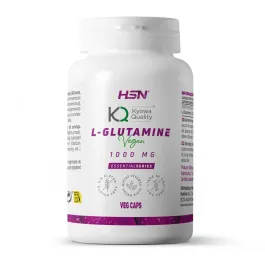
L-GLUTAMINE 1000mg
Pure L-Glutamine in vegetable capsules. Conditionally essential amino acid from vegetable fermentation. High concentration: 1 gram per unit. Gluten-free. GMO-free. Vegan-friendly. Important for both vegans and athletes.




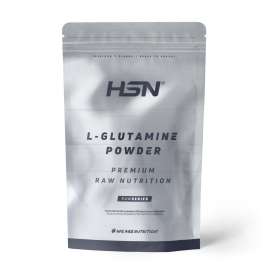
L-GLUTAMINE POWDER

L-GLUTAMINE (Kyowa Quality®) POWDER

CREATINE MONOHYDRATE POWDER

ESSENTIAL AMINO ACIDS (EAA'S) POWDER

FLAVOUR SYSTEM FOR AMINO ACIDS & SPORT DRINKS
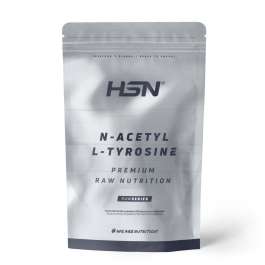
N-ACETYL L-TYROSINE POWDER

EVOEAA'S ENERGY
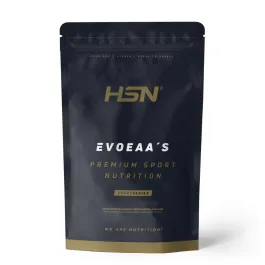
EVOEAA'S
- Pure L-Glutamine in vegetable capsules.
- 1000mg of pure amino acid per capsule.
- Glutamine from vegetable fermentation.
- Gluten-free. Not from any source of wheat or derivatives.
- Conditionally essential amino acid.
- Important in: vegetarian and vegan diets; and high-intensity athletes.
- Product suitable for vegan diets.
Table of contents

L-Glutamine 1000mg. Conditionally essential amino acid
L-Glutamine 1000mg by EssentialSeries is a dietary supplement in vegetable capsules based on L-glutamine from vegetable fermentation.
L-glutamine is the most abundant amino acid in the human body. They constitute up to 60% of the entire amino acid concentration of muscle (Cruzat et al., 2018). It's considered a non-essential amino acid in sedentary and healthy people, however, for the elderly, high-level athletes, or whenever there's a situation that involves a great loss of muscle mass, the scientific literature classifies this amino acid as 'conditionally essential' or 'semi-essential', because the body isn't able to produce sufficient quantities to meet its needs.
Its capsule format is convenient to carry and means it can be used whenever you're away from home or on a trip. The powder format is also perfect for making your own amino acid mixtures or for use at home. Available: Pure L-Glutamine powder.
L-Glutamine in capsules by HSN. This isn't just any glutamine!
In vegetable capsules. How and why?
Amino acids, as well as other dietary supplement compounds, can be presented in different formats, the most common being: Capsule, Tablet, Powder and Liquid.
Amino acids such as glutamine don’t come in liquid format as they're unstable in the environment and degrade rapidly.
Tablets are problematic as they require additives, in the case of glutamine, to get them to compress so that they don't fall apart or release dust, an undesirable effect and sure sign of lack of care in the development process.
Powder is a popular supplement format and at HSN you'll find several options for L-Glutamine in powder format. You can choose the format that best suits your needs!
Another common format for this amino acid is to find Glutamine in capsules, which are easy to carry for use after your training sessions, at meals away from home, or if you're travelling, meaning you’ll never have to go without your supplement.
However, most companies on the market use capsules that aren't suitable for vegetarian diets because they're made from animal-based gelatines. What a pity!
How can it be that a compound like L-Glutamine, which is completely suitable for vegan diets, isn’t suitable for vegan diets because gelatine is used to make the capsules? At HSN, we knew there must be a solution!
And there is, using treated vegetable cellulose to obtain a suitable consistency to make capsules: HPMC, the cellulose derivative we use to encapsulate our amino acid glutamine.
Suitable for everyone and with all the benefits of traditional capsules.

High concentration per unit
Amino acids pose a problem when taken in capsules and tablets: they require high daily doses. And this means that if the product isn’t well designed, taking them can be extremely inconvenient.
For example, a typical 4-gram dose of glutamine is one scoop of powdered product, which you take quickly and be done with it, but can you imagine having to consume glutamine in 250mg capsules?
To avoid this, many companies use the famous (and dreaded) triple 0 '000' capsules, which are huge and often hard to swallow, even with water.
At HSN, we work with raw materials of controlled density to fully optimise the manufacture of our dietary supplements, and our L-glutamine capsules provide no less than 1 gram of pure glutamine amino acid per unit without having to use 000 capsules.
Getting your daily dose has never been easier.
Vegetable fermentation. Certified gluten-free
Did you know that many amino acids have animal origin?
Duck feathers, as well as the fur of certain species of mammals, are raw materials traditionally (and continue to be) used in the industry to manufacture amino acids.
This obviously makes amino acids not suitable for vegan diets.
Synthesis is a way out of this, but why make chemical nutrients if they can be obtained naturally?
Our L-glutamine is both suitable for vegans and non-synthetic: it comes from vegetable sources and is obtained through fermentation processes.
The process is complex, but essentially it involves finding vegetables with a high carbohydrate content, which serves as a substrate for good bacteria to ferment in controlled tanks and separate their nutrients. After this, various sterilisation, cleaning, filtering and pumping separation processes are carried out to purify the nutrients of interest, in this case, glutamine, obtaining an amino acid as pure as the synthesis. 100% L-glutamine.
The fermentation substrate used for glutamine isn't wheat, oats, rye, or barley; it's a raw material of vegetable origin that doesn't contain gluten, hence our L-glutamine, in addition to being an amino acid of maximum purity, is gluten free. Guaranteed!
No unnecessary additives
Our L-glutamine capsules are developed with the lowest possible additive content. At HSN, we are committed:
We don't use additives for aesthetic or unnecessary purposes to guarantee that the product is preserved in the best possible way and with all quality guarantees when used.
That's why you’ll only find additives you're familiar with, such as leucine, an amino acid found in proteins, or calcium phosphate, a calcium mineral salt that prevents glutamine from clumping inside the capsule over time.
We formulate our products with the best quality raw materials, every safety guarantee, and only what's needed, so that you and yours can use them with complete peace of mind.
Capsules or powder?
We've already seen the advantages and disadvantages of both formats. But which do you prefer?
Amino acids are often used in powder format when they're to be mixed into protein shakes such as evowhey 2.0; or with other compounds to make recovery drinks or homemade pre-workouts.
However, when its use is unique and isolated, capsules are an excellent option:
- They mean you won't make any mistakes in the dosage.
- They don't stain.
- They're versatile, convenient to use home or away.
At HSN, we have some colleagues who love the powder format and others who vote for the capsules!
Which is the one for you?
Now, let's explore some of Glutamine's secrets!

Sources of glutamine in the diet
You may wonder if you're already regularly consuming glutamine in your diet. The answer is yes!
This amino acid is present in the form of L-glutamic acid in many of the foods you eat on a daily basis, with some of the best sources being of animal origin, such as meats (especially bovine) and dairy products.
Normally, around 5-6 grams of glutamine are consumed on a regular basis on a western diet with no dietary restrictions.
If you eat a high-protein diet or use protein shakes such as whey or egg albumin protein, your L-glutamine intake will be higher, and this is especially important if you’re an athlete, as your daily glutamine requirements will be higher.
If, on the other hand, you’re on a low-protein diet, or don't eat meat or dairy, dietary supplementation with pure L-glutamine may be a great option for you.
Recommendations: Veganism and High-Level Sport
Glutamine is very rarely present in plant foods, as the main dietary sources of the amino acid are milk, eggs and meat, i.e. primarily foods of animal origin.
Strict vegetarians, especially when they're athletes and have increased nutritional needs, may benefit from the consumption of dietary supplements based on this amino acid.
These are the two populations for whom the use of L-Glutamine is most recommended, and there's no better way to do this than by using EssentialSeries L-Glutamine 1000mg.
Use in low FODMAP diets
L-Glutamine is an amino acid widely used in low FODMAP diets.
These diets have become increasingly well-known in recent years due to the prevalence of digestive disorders in the Western population, resulting from inadequate dietary intake over time. A low FODMAP diet involves a low dietary presence of:
- Fructose.
- Oligosaccharides.
- Disaccharides.
- Monosaccharides.
- Polyalcohols.
This significantly diminishes the variety of foods that can be consumed, and in such cases glutamine is often used as a supplement.
Scientific studies suggest the potential use of this amino acid in the diet:
- Rastgoo, S., Ebrahimi-Daryani, N., Agah, S., Karimi, S., Taher, M., Rashidkhani, B., … Hekmatdoost, A. (2021). Glutamine Supplementation Enhances the Effects of a Low FODMAP Diet in Irritable Bowel Syndrome Management. Frontiers in Nutrition, 8.
Don't miss Glutamine for a low FODMAP diet!
Fasting or with food
Glutamine can be taken both on an empty stomach and with food.
We recommend taking it with meals as it comes in capsule format and can cause heartburn and digestive discomfort in those not used to taking capsules on an empty stomach.
If you've taken glutamine on an empty stomach before, you can continue doing so without problems.
An amino acid that can be combined with other amino acids
L-glutamine is a very important amino acid in the nutritional landscape, and it's widely used by athletes and those looking to supplement their diet with the compound on a regular basis.
However, sometimes people believe glutamine isn't usable in combination with other amino acids. But that's far from the truth! It's a great idea.
You can continue using it in combination with products such as:
- Evoeaas (essential amino acids or EAAs).
- L-Leucine.
- L-Arginine.
L-Glutamine 1000mg is an amino acid that can be used together with a range of other dietary supplements in your daily routine.
What other products, besides amino acids, can I combine with L-Glutamine 1000mg?
In addition to other amino acids, you can use it together with:
External references on glutamine
- Castell, L. M., & Newsholme, E. A. (2001). The relation between glutamine and the immunodepression observed in exercise. Amino Acids, 20(1), 49–61.
- Cruzat, V., Rogero, M. M., Keane, K. N., Curi, R., & Newsholme, P. (2018). Glutamine: Metabolism and immune function, supplementation and clinical translation. Nutrients, 10(11).
- Kim, M. H., & Kim, H. (2017). The roles of glutamine in the intestine and its implication in intestinal diseases. International Journal of Molecular Sciences, 18(5), 1051.
Nutritional FactsL-GLUTAMINE 1000mg - 120 veg caps |
| daily doseper serving |
| Serving size: 2 veg caps | ||
| daily dose: 4 veg caps | ||
| Servings per container: 60 | ||
| Daily amount | ||
|---|---|---|
| L-Glutamine | 4000mg | |
Ingredients
L-glutamine (produced through a vegetable fermentation process), vegetable capsule [glazing agent (hydroxypropyl methyl cellulose)], hydrolysed rice flour, anti-caking agent (L-leucine), anti-caking agent (tricalcium phosphate).
Warnings
Store in a cool (below 25°C), dry and dark place. Do not exceed the stated recommended daily dose. Keep out of reach of the smallest children. Nutritional supplements should not be used to replace a balanced diet. It is necessary to maintain a varied and balanced diet and a healthy lifestyle. Health claim awaiting European authorization.

How to take L-GLUTAMINE 1000mg - 120 veg caps
Take 2 vegetable capsules in the morning and 2 vegetable capsules at night, preferably with meals.
The product reviews and opinions published reflect only the customers’ views and experiences. HSN does not verify or endorse such comments or claims, and is not responsible for the content provided in the reviews. Statements regarding food supplements have not been evaluated by the EFSA (European Food Safety Authority) and are not intended to diagnose, treat, cure, or prevent any disease or medical condition.
The product reviews and opinions published reflect only the customers’ views and experiences. HSN does not verify or endorse such comments or claims, and is not responsible for the content provided in the reviews. Statements regarding food supplements have not been evaluated by the EFSA (European Food Safety Authority) and are not intended to diagnose, treat, cure, or prevent any disease or medical condition.
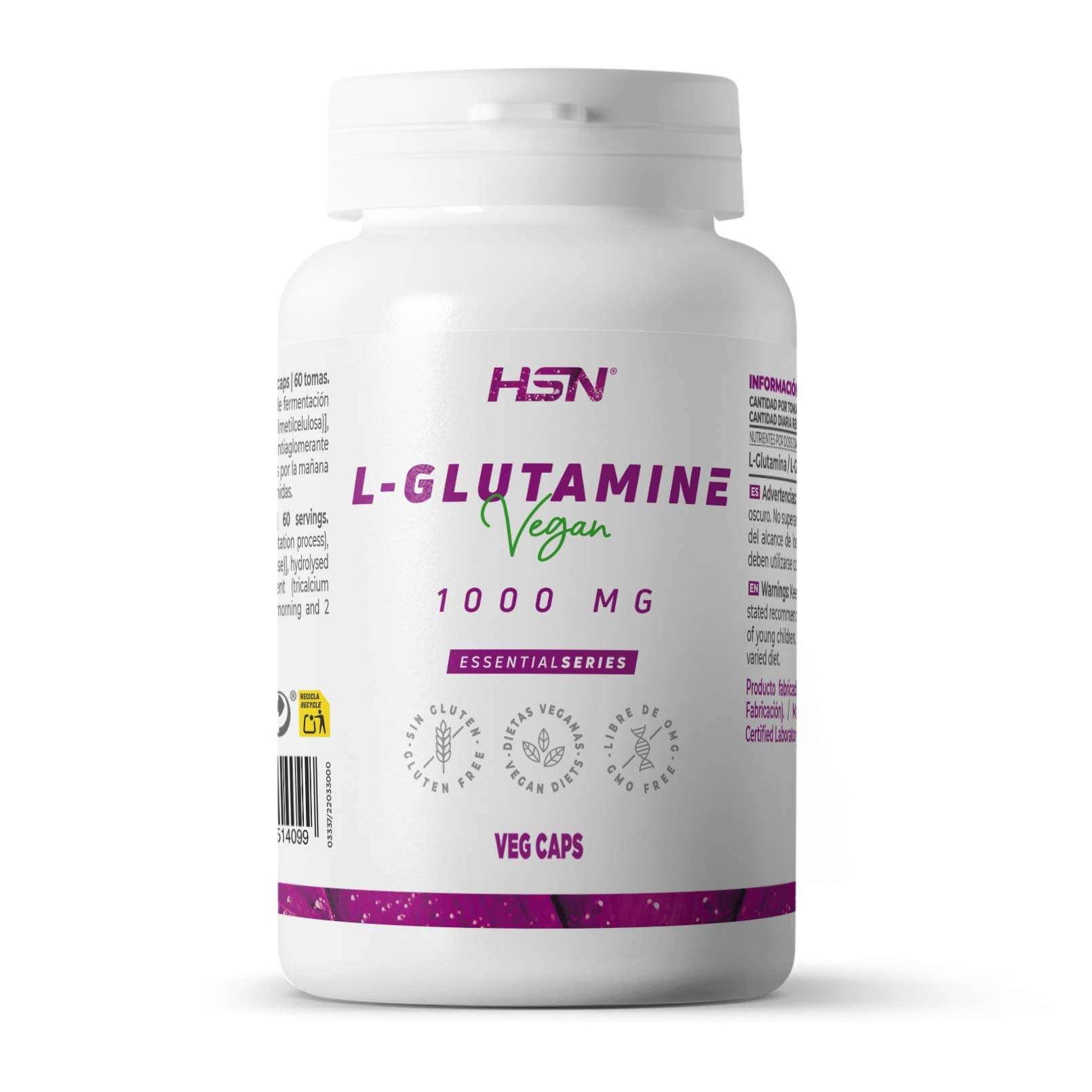
A satisfied customer says:
Very necessary product for daily supplementation.
Yurena 23/07/2023
It is great for abdominal swelling. It is a great product for everyday use. It helps a lot with digestive problems and fantastic value for money.
Show original language
A critical customer says:
I prefer it in powder form
Daniel 15/02/2024
I think if you want to best get the benefits of glutamine you are better off taking the powdered supplement, or at least, I prefer it after trying both.
Show original language-
Glutamine tablets
José miguel 24/07/2025
Great for the gym and for the digestive system, bloating and abdominal pain. Good buy.
Show original languageWas the review helpful? Be thefirst one to rate the review -
Very good
Natália 14/06/2025
I was taking it 3 times a day and I think it really helped to heal my intestines, my ferritin went up to normal after 2 months of taking it.
Show original languageWas the review helpful? Be thefirst one to rate the review -
Good value for money
Soraia 30/05/2025
I prefer this capsule format to soluble powder because it's more practical, but the capsules are bigger than I expected. Good value for money.
Show original languageWas the review helpful? Be thefirst one to rate the review -
Great value for money
Paula 20/05/2025
L-Glutamine is useful in low FODMAP diets to supplement nutrients. I bought it because it is also beneficial for gut health, as I have issues. I am still checking to see if it is any good.
Show original languageWas the review helpful? Be thefirst one to rate the review -
After intense training
PEPI 18/05/2025
A supplement that is noticeable, it helps you recover from intense training. Good value for money. I recommend it.
Show original languageWas the review helpful? Be thefirst one to rate the review
No reviews found with filters applied.
{title}
{nickname-date}
{detail}
{review-link} EN - EUR
EN - EUR Albania
Albania  Austria
Austria  Belgique
Belgique  Bosnia and Herzegovina
Bosnia and Herzegovina  Bulgaria
Bulgaria  Canadá
Canadá  Chile
Chile  Chipre
Chipre  Corea (la República de)
Corea (la República de)  Croacia
Croacia  Czechia
Czechia  Denmark
Denmark  Deutschland
Deutschland  Eslovaquia
Eslovaquia  Eslovenia
Eslovenia  Estonia
Estonia  Finland
Finland  France
France  Greece
Greece  Hungary
Hungary  Iceland
Iceland  Ireland
Ireland  Islas Feroe
Islas Feroe  Italia
Italia  Japan
Japan  Latvia
Latvia  Lithuania
Lithuania  Luxembourg
Luxembourg  Macedonia
Macedonia  Malta
Malta  Marruecos
Marruecos  Mónaco
Mónaco  Montenegro
Montenegro  Netherlands
Netherlands  Noruega
Noruega  Poland
Poland  Portugal
Portugal  Romania
Romania  Schweiz
Schweiz  Serbia
Serbia  South Africa
South Africa  Suecia
Suecia 

 View full analysis
View full analysis 